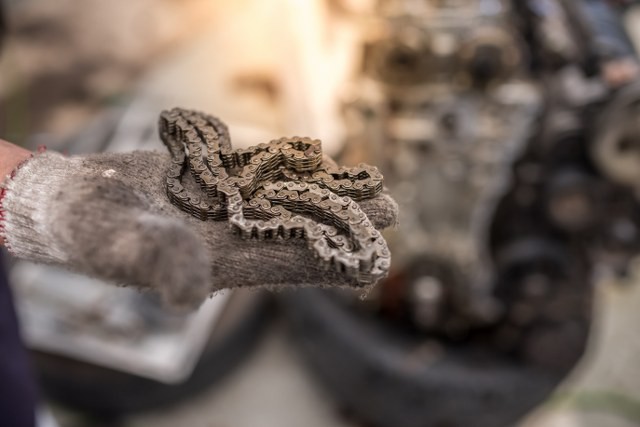
5 Symptoms of a Worn-Out or Faulty Timing Chain
Since
the development of the internal combustion engine, one constant has remained:
they all have a timing chain or belt. Majority of higher-displacement engines
employ a timing chain rather than a timing belt.
The
chain is connected to a set of gears and pulleys towards the front of the
engine that drives the crankshaft and camshaft, among other mechanical
components. In order for your engine to ignite, the timing chain must correctly
rotate around the gears without trouble.
Even
though the timing chain is comprised of metal, it is prone to wear and tear,
and it may break if not replaced as the manufacturer recommends. It's a good
idea to refer to your owner's manual to determine when a timing chain
replacement is required and to schedule an appointment with a car repairs
garage within time.
Similar
to a bicycle chain, the timing chain is made up of many links. The links, which
open and close valves in the cylinder head and move pistons and connecting rods
in the combustion chamber, are moved by toothed sprockets on the crankshaft and
camshaft's extremities. The timing chain can stretch and wear down over time,
causing the engine's timing to be off and a few warning signs to appear.
Here
are five signs that your timing chain is worn out. If you observe any of these
symptoms, you should look online for car garages in Reading and call a local
car mechanic as soon as possible to diagnose the problem and make any
necessary repairs:
1. Engine misfires or runs
badly - In a combustion engine, valve timing may be achieved in two ways. The
first is the two-gear technique, which involves a direct connection between the
crankshaft and camshaft gears. This is the approach employed in the majority of
heavy machinery and large vehicles. Cars with high-performance engines are more
likely to use the timing chain approach. The timing chain can stretch with
time, causing the chain to skip a gear on the camshaft or crankshaft. This
causes the engine's timing to go out of whack, resulting in a misfire. It's
also possible that the engine will operate badly and lack accelerating power.The
timing chain will very probably be destroyed if this happens, and it will need
to be replaced as soon as possible. Make an appointment with a qualified
technician by searching for car repairs near
me on the internet. The loose metal rolling about inside the engine if
the timing chain breaks might cause some serious damage to the engine.
2. Metal shavings in the
engine oil - All vehicle manufacturers recommend changing the engine oil and
filter every 3,000 to 5,000 miles. As oil warms up and is exposed to natural
solvents contained in fuel, it begins to separate over time. Small metal
fragments can break off the timing chain and end up in the oil pan if it begins
to wear down. When you get your oil changed and the mechanic informs you that
there were little pieces of metal inside the oil as it drained or in the
filter, it's a sign that your timing chain is failing.Metal shavings are a
frequent occurrence when cylinder head valves, keepers, retainers, and other
cylinder head components wear down. It's critical to look for garages in Reading
online as soon as possible so that a technician or professional can assess the
problem and make the necessary repairs.
3. Engine will not start - If
the timing chain is destroyed, the engine will either not start or fail while
driving. If the chain has already snapped, the engine will be impossible to
start. If it breaks or leaps while being driven, the pistons will be destroyed
by contact with the valves. Because the valves flex, the engine may fail. If
the belt becomes loose, it can flail around, damaging other engine components.
If your engine won't start or starts driving rough, it may be on its way to
failing. Contact a skilled mechanic for an evaluation and repairs.
4. The ‘check engine’ light
is on - The engine management light may appear for a number of
causes, including a malfunctioning timing chain. The warning lights on a car's
computer must be investigated and trouble codes read to pinpoint the cause of
the problem. If the onboard computer identifies a problem with the emissions
system or engine functioning, the check engine light will illuminate. The check
engine light and the storage of a diagnostic issue code are triggered by a
stretched timing chain, which results in poor engine performance and higher
emissions. The code will need to be examined by a mechanic, who will then
recommend the necessary repairs.
5. Engine rattles when idling
- Strange noises are another potential symptom of a problem with your engine.
The engine should make a constant, smooth sound under typical circumstances,
suggesting that everything is working properly. When the timing chain is
faulty, however, it can generate a vibration inside the engine, resulting in a
rattling noise when the engine idles. A rattling indicates that something is
loose and has to be addressed before it breaks.
Every
engine requires a timing chain, and your vehicle would be useless without one.
Your vehicle's engine will most certainly suffer substantial damage if your
timing chain breaks while you're driving. If any of the abovementioned warning
signs appear, having your timing chain replaced by a qualified technician is
the best way to avoid catastrophic engine damage. Being vigilant and aware
might help you save thousands of pounds and extend the life of your engine.